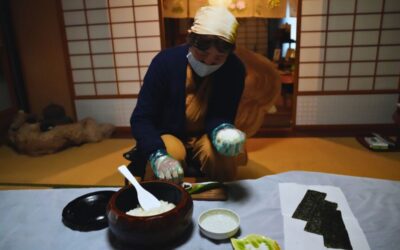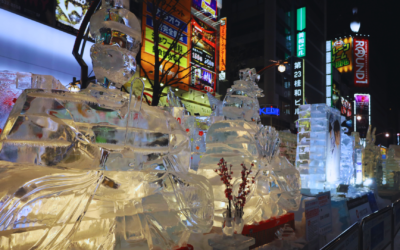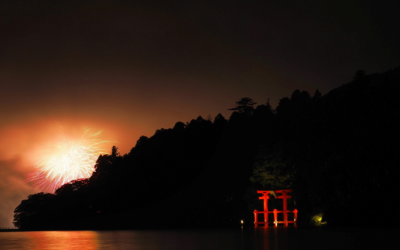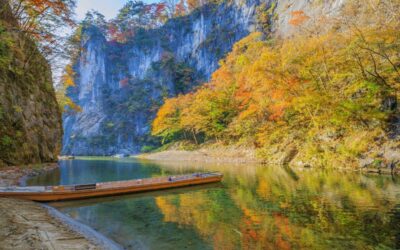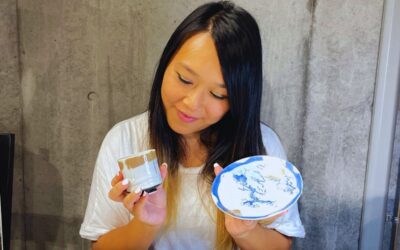Travelling in Japan in July offers a vibrant mix of summer festivals, outdoor activities, and seasonal delights. With the rainy season coming to an end and the heat of summer setting in, it’s a dynamic time to explore the country. This guide provides essential tips for travelling in July in Japan, focusing on weather preparedness, festivals, and seasonal highlights.
July is often overlooked when considering the best month to visit Japan, but we’re here to tell you that the matsuri festivals, spectacular fireworks, delicious summer treats, and lack of crowds might actually make July and summer in Japan, our favourite time to visit.
July in Japan: Understanding the Weather

Japan’s weather in July is characterized by warm temperatures and high humidity, marking the full onset of summer. Being prepared for the weather is key to enjoying your trip.
Regional Weather Differences
Hokkaido
Hokkaido, the northernmost island of Japan, experiences mild summer weather in July. Temperatures typically range from 17 to 25 degrees Celsius. The region remains cooler and less humid than the rest of Japan, making it an ideal destination to escape the summer heat. The pleasant climate makes it perfect for outdoor activities like hiking and sightseeing.
Tohoku
The Tohoku region, located in the northeastern part of Honshu, enjoys moderate temperatures in July, ranging from 20 to 28 degrees Celsius. The rainy season ends earlier here, leading to fewer showers and clearer skies. The combination of comfortable temperatures and lush greenery makes Tohoku a beautiful destination in July.
Kanto
The Kanto region, including Tokyo, experiences hot and humid weather in July. Temperatures range from 24 to 31 degrees Celsius. While the rainy season typically ends in early July, occasional showers can still occur. It’s important to stay hydrated and carry sun protection while exploring the bustling city of Tokyo and its surroundings.
Kansai
The Kansai region, including cities like Osaka, Kyoto, and Nara, also experiences hot and humid weather in July. Temperatures generally range from 25 to 32 degrees Celsius. Despite the heat, Kansai’s cultural attractions and festivals are particularly vibrant during this time, drawing large crowds.
Chubu
The Chubu region, home to the Japanese Alps and cities like Nagoya, sees variable weather in July. Coastal areas are warm and humid, with temperatures ranging from 24 to 30 degrees Celsius. Mountainous areas like the Japanese Alps are cooler, with temperatures ranging from 15 to 25 degrees Celsius, making them ideal for hiking and outdoor activities.
Chugoku
The Chugoku region, located in the western part of Honshu, experiences typical summer weather with high humidity and occasional showers. Temperatures range from 24 to 31 degrees Celsius. The coastal areas, including Hiroshima, can be quite humid, while inland areas like Okayama might be slightly drier. July is a great time to visit Chugoku’s historical sites and scenic landscapes.
Shikoku
Shikoku, the smallest of Japan’s four main islands, experiences hot and humid weather in July. Temperatures range from 25 to 31 degrees Celsius. The region sees occasional rain showers, particularly in the southern parts. Shikoku’s lush valleys and vibrant festivals make it an attractive destination despite the humid weather.
Kyushu
Kyushu, the southernmost of the main islands, experiences some of the highest temperatures and humidity levels in July. Temperatures range from 26 to 33 degrees Celsius. The region can also experience occasional typhoons. However, Kyushu’s hot springs and lush landscapes are particularly appealing during this time.
Okinawa
Okinawa, a subtropical island chain, enjoys warm temperatures in July, ranging from 27 to 32 degrees Celsius. The rainy season has typically ended, making it an excellent time to enjoy Okinawa’s stunning beaches and marine activities.
July in Japan: Tips for Packing Appropriately
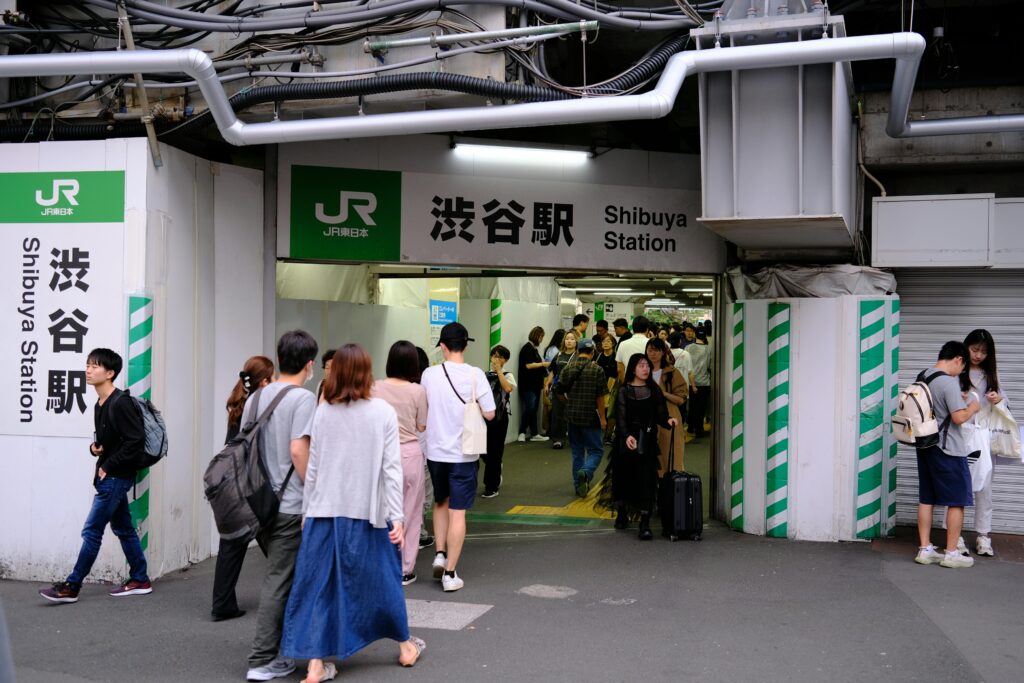
Packing the right clothing and gear is crucial for a comfortable and enjoyable trip when travelling in Japan in July. The hot and humid weather requires a thoughtful selection of items to ensure you stay cool and comfortable.
Light Clothing
- Breathable Fabrics: Lightweight, breathable fabrics such as cotton and linen are ideal for the warm temperatures in July. These materials help keep you cool and comfortable by allowing air to circulate and moisture to evaporate quickly.
- Quick-Drying Clothes: Consider packing quick-drying clothing made from moisture-wicking materials. These are especially useful if you get caught in a rain shower, as they dry faster and help you stay comfortable.
- Comfortable Attire: Loose-fitting clothes are preferable as they allow better air circulation and are more comfortable in humid conditions. Dresses, skirts, and loose trousers are excellent choices for both comfort and style.
- Sun Protection: Even though it’s summer, sun protection is essential. Pack a wide-brimmed hat and lightweight long sleeves to protect your skin from the sun.
Rain Gear

- Umbrella: A compact, high-quality umbrella is an essential item. Choose one that is sturdy enough to withstand strong winds yet small enough to carry easily. Many convenience stores in Japan sell affordable and durable umbrellas if you need one while on the go.
- Rain Jacket: A lightweight, waterproof rain jacket is another must-have. Look for a jacket with good ventilation to prevent overheating. Packable rain jackets that fold into small pouches are convenient for travel.
- Poncho: For added protection, especially during heavy downpours, consider packing a poncho. Ponchos can cover both you and your backpack, keeping more of your belongings dry.
Waterproof Footwear
- Waterproof Shoes: Waterproof shoes are recommended to keep your feet dry and comfortable during rainy spells. Shoes made from materials like Gore-Tex or treated leather are excellent choices. They offer protection from the rain while allowing your feet to breathe.
- Quick-Drying Sandals: If you prefer sandals, choose ones made from quick-drying materials like rubber or certain types of synthetic fabrics. Sandals with good traction are essential for slippery surfaces.
- Comfortable Walking Shoes: Regardless of the weather, you’ll likely be doing a lot of walking. Ensure your waterproof footwear is also comfortable and provides good support for long days of exploration.
Layers
- Cardigans and Light Jackets: Evenings can sometimes be cooler, especially in the mountains or near the coast. Packing a light cardigan or jacket can help you stay warm. Opt for items that are easy to layer and pack away when not needed.
- Versatile Layers: Consider versatile pieces that can be layered together for added warmth. For example, a long-sleeve shirt under a light jacket provides more warmth than either piece alone.
- Packable Warm Layers: For trips to mountainous regions or cooler areas, pack a lightweight, packable down jacket. These jackets provide excellent warmth without taking up much space in your luggage.
Additional Packing Tips
- Portable Fan: High humidity can make the air feel warmer than it is. A small, portable fan can help keep you cool while you’re out and about.
- Reusable Water Bottle: Staying hydrated is essential, especially in warm and humid weather. Carry a reusable water bottle to refill throughout the day. Many public places in Japan have water fountains.
- Moisture-Wicking Socks: Pack moisture-wicking socks to keep your feet dry and comfortable, especially if you plan on doing a lot of walking.
- Waterproof Bags: Protect your electronics and other valuables by packing them in waterproof bags or pouches. This is particularly important if you get caught in a heavy rain shower.
Japanese Festivals and Events in July
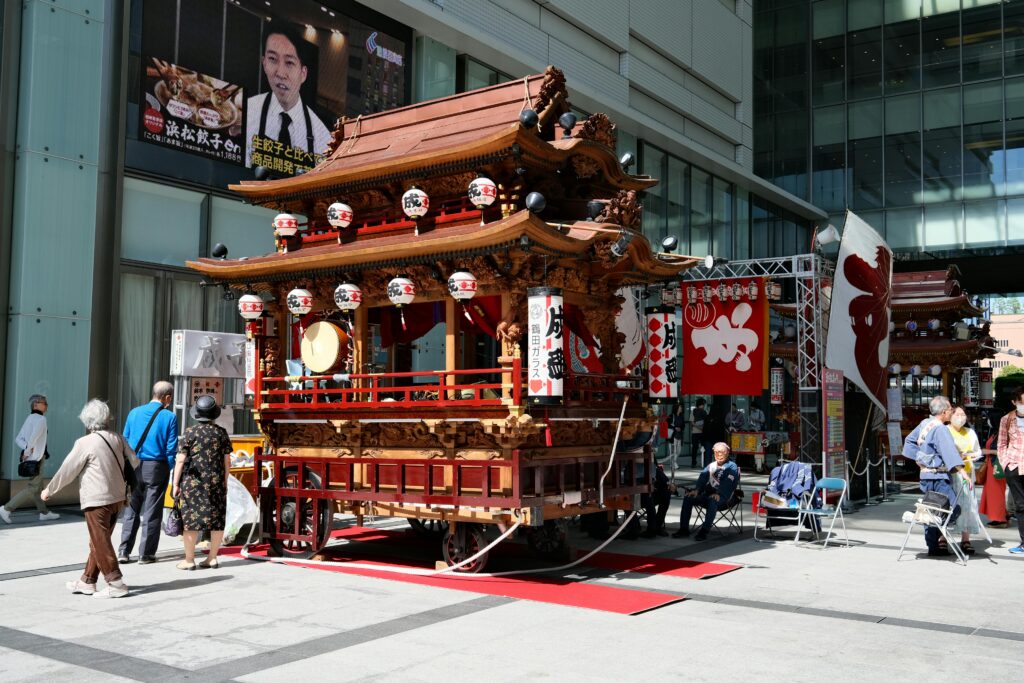
July is a vibrant month for festivals and events in Japan. These festivals offer a glimpse into Japanese culture and are often more crowded than those in June due to the summer holidays. Here’s a regional breakdown of the biggest events and festivals in July.
Tokyo
Tanabata Festival
Celebrated on July 7th, the Tanabata Festival is based on a romantic legend and is marked by colourful decorations, wishing trees, and traditional festivities. Asakusa and Shitamachi Tanabata Festivals are particularly famous in Tokyo.
- Official website: Asakusa Tanabata
Sumida River Fireworks Festival
Held on the last Saturday of July, this is one of Tokyo’s most famous fireworks festivals. Thousands of fireworks light up the sky over the Sumida River, attracting large crowds.
- Official website: Sumida River Fireworks
Osaka
Tenjin Matsuri
Held on July 24th and 25th, the Tenjin Matsuri is one of Osaka’s most famous festivals. It features a grand procession with mikoshi (portable shrines), traditional music, dance performances, and a spectacular fireworks display.
- Official website: Tenjin Matsuri
Kanagawa
Yokohama Sparkling Twilight
This festival, held in mid-July, features fireworks, live performances, and food stalls along the Yokohama waterfront. It’s a beautiful event that celebrates summer with a vibrant atmosphere.
- Official website: Yokohama Sparkling Twilight
Kyoto
Gion Matsuri
One of Japan’s most famous festivals, Gion Matsuri, takes place throughout July. The highlight is the grand procession of floats on July 17th and 24th. The festival features traditional music, dance, and street stalls.
- Official website: Gion Matsuri
Shizuoka
Atami Fireworks Festival
Held multiple times throughout July, this festival in Atami City features stunning fireworks displays over the ocean. The festival provides a beautiful backdrop with the fireworks reflecting on the water.
- Official website: Atami Fireworks
Hokkaido
Sapporo Summer Festival
Running from late July to mid-August, the Sapporo Summer Festival includes beer gardens, traditional dance performances, and various outdoor activities. It’s a lively event that celebrates the best of Hokkaido’s summer.
- Official website: Sapporo Summer Festival
Kyushu
Hakata Gion Yamakasa
This dynamic festival in Fukuoka City features teams racing through the streets carrying elaborately decorated floats. The climax of the festival is on July 15th, attracting thousands of spectators.
- Official website: Hakata Gion Yamakasa
Exploring Nature in Japan in July
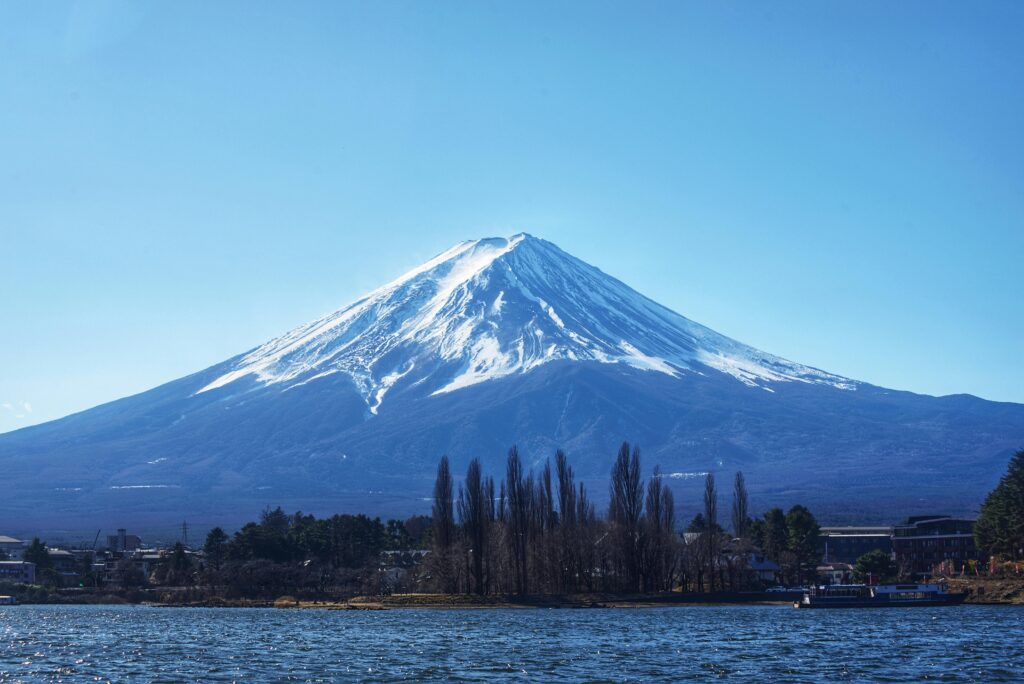
July is a wonderful month to explore Japan’s natural beauty. The landscapes are lush and vibrant, and the weather is warm, making it perfect for outdoor activities. Here are some specific places and hiking opportunities to consider in July, including links to official websites for more information.
Hiking in July
Mount Fuji
July marks the official start of the climbing season for Mount Fuji. The trails are open, and the weather is ideal for a climb to Japan’s highest peak. Be sure to prepare adequately for the hike and book accommodations in advance.
- Official website: Mount Fuji Climbing
Kamikochi
This scenic mountain valley in the Northern Alps is perfect for nature lovers. The well-maintained trails, stunning landscapes, and diverse wildlife are enchanting in July. The cooler temperatures and abundant greenery make it an excellent time to visit.
- Official website: Kamikochi
Daisetsuzan National Park
Located in Hokkaido, Daisetsuzan National Park is Japan’s largest national park and offers spectacular hiking opportunities. In July, the park’s trails are surrounded by fresh greenery and wildflowers. The cooler climate of Hokkaido makes it a perfect destination for those looking to escape the humidity of other regions.
- Official website: Daisetsuzan National Park
Gardens and Parks in July
Kenrokuen (Kanazawa)
One of Japan’s most famous landscape gardens, Kenrokuen is especially beautiful in July when the summer flowers are in full bloom. The garden’s carefully maintained landscapes become even more lush and vibrant due to the warm weather.
- Official website: Kenrokuen
Shinjuku Gyoen (Tokyo)
This spacious park offers a mix of traditional Japanese, English, and French garden styles. The summer blooms in July make it a picturesque spot for a leisurely stroll. The park’s layout allows for peaceful walks among the seasonal flowers.
- Official website: Shinjuku Gyoen
Korakuen Garden (Okayama)
Korakuen Garden, one of Japan’s three great gardens, is particularly stunning in July. The garden features expansive lawns, ponds, and groves of plum, cherry, and maple trees. The warm weather brings out the vibrant green hues, and the garden’s design ensures that it is enjoyable even in hot conditions.
- Official website: Korakuen Garden
Ritsurin Garden (Takamatsu)
Located in Takamatsu, Ritsurin Garden is a historical Japanese garden that is exceptionally beautiful in July. The garden features meticulously designed landscapes, koi ponds, and traditional teahouses. The warm weather adds a fresh and vibrant look to the garden’s flora.
- Official website: Ritsurin Garden
Make the Most of Your July Trip with Flip Japan Guide
Travelling in Japan in July offers a unique opportunity to experience the country’s rich natural beauty and vibrant culture. From the lush, green mountains of Kamikochi to the lively festivals of Gion Matsuri, there’s no shortage of breathtaking sights and exciting activities.
At Flip Japan Guide, we offer guided tours and free consultations to help you plan the perfect itinerary. Whether you’re looking for guided hikes or need assistance choosing the best festivals to visit, our experts are here to help.
Visit our website at Flip Japan Guide to learn more about our services and start planning your unforgettable July adventure in Japan.
July in Japan: Seasonal Foods
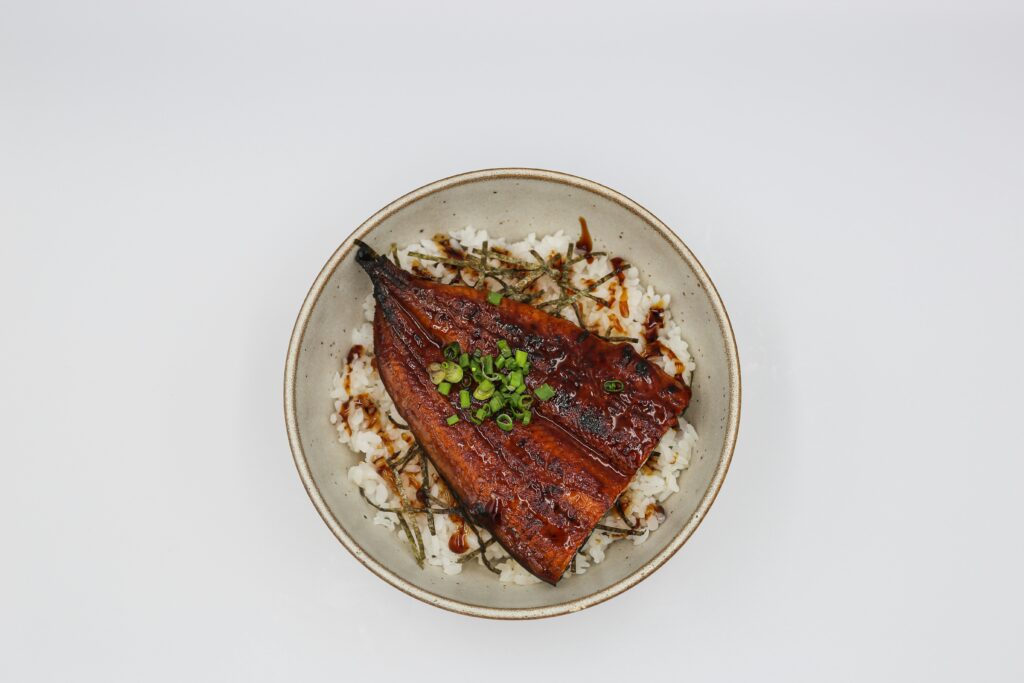
July is a wonderful time to indulge in Japan’s seasonal foods. The height of summer brings a variety of delicious and refreshing dishes that are perfect for the warm weather. Here are some regional specialties to look out for during your travels in Japan.
Unagi (Eel)
Unagi is considered a summer delicacy in Japan. Grilled eel, served over rice as unadon or unaju, is believed to provide stamina and energy during the hot months. The rich, flavorful meat is often coated with a sweet soy-based sauce and grilled to perfection. July is an excellent time to try this dish, as it is often featured in seasonal menus.
- Kanto Region (Tokyo and Surroundings): In Tokyo, you can find some of the best unagi restaurants, many of which have been operating for generations. The Kanto style of cooking unagi involves steaming the eel before grilling, resulting in a tender and fluffy texture.
- Kansai Region (Osaka and Kyoto): In Kansai, the eel is grilled without steaming first, giving it a slightly firmer texture and a more robust flavor. Kyoto’s traditional restaurants, known as ryotei, often serve unagi in a variety of refined dishes.
- Nagoya: In Nagoya, a unique variation known as hitsumabushi is popular. The dish is served in a wooden container and includes instructions on how to enjoy it in different ways – with condiments, as a rice bowl, or with broth poured over it.
Kakigori (Shaved Ice)
A popular summer treat, kakigori is made with finely shaved ice topped with flavored syrups and sometimes condensed milk. This refreshing dessert is a favorite among locals and tourists alike, especially during the hot and humid days of July. Popular flavors include matcha (green tea), strawberry, and melon, but many cafes and street vendors offer unique variations.
- Tokyo: In Tokyo, trendy cafes in neighborhoods like Harajuku and Shimokitazawa offer gourmet kakigori with exotic flavors and toppings such as fresh fruit, azuki beans, and even edible flowers.
- Kyoto: Kyoto’s traditional tea houses often serve matcha-flavored kakigori, sometimes topped with sweet red beans and mochi. This combination is perfect for those looking to enjoy a taste of Japanese tradition.
- Okinawa: In Okinawa, you can find tropical flavors such as mango and pineapple. The island’s hot climate makes kakigori a popular choice for cooling down, and many vendors add local touches like Okinawan brown sugar syrup.
Other Seasonal Delicacies
- Hamo (Pike Conger Eel): Hamo is a delicacy particularly popular in Kyoto during the summer months. The eel is known for its numerous small bones, which are meticulously prepared by skilled chefs. Hamo is often served in light, refreshing dishes such as hamo no yudofu (boiled eel in a light broth) or as sashimi.
- Ayugashi (Sweetfish Sweets): Ayugashi, or sweets shaped like sweetfish, are a charming summer treat. These confections are made from sweet bean paste and are often enjoyed during the festival season in July. They can be found in many traditional sweet shops across Japan.
- Watermelon: Watermelon is a classic summer fruit in Japan, enjoyed for its refreshing and hydrating qualities. In July, you can find various watermelon-based treats, including watermelon-flavored ice cream and kakigori.
- Hiyayakko (Chilled Tofu): Hiyayakko is a simple and refreshing dish made of chilled tofu topped with green onions, ginger, and soy sauce. It’s a perfect dish to cool down during the hot summer days of July.
- Nagashi Somen: In some regions, you can experience nagashi somen, where the noodles are floated down a bamboo flume filled with cold water, and diners catch them with chopsticks. This interactive dining experience is particularly popular during the hot summer months.
- Hydrangea Wagashi: In July, traditional Japanese confectioneries often produce wagashi (Japanese sweets) inspired by the blooming hydrangeas. These delicate and beautifully crafted sweets are made from sweet bean paste and rice flour, mimicking the vibrant colors and shapes of hydrangea flowers.
July in Japan: Going to the Beach
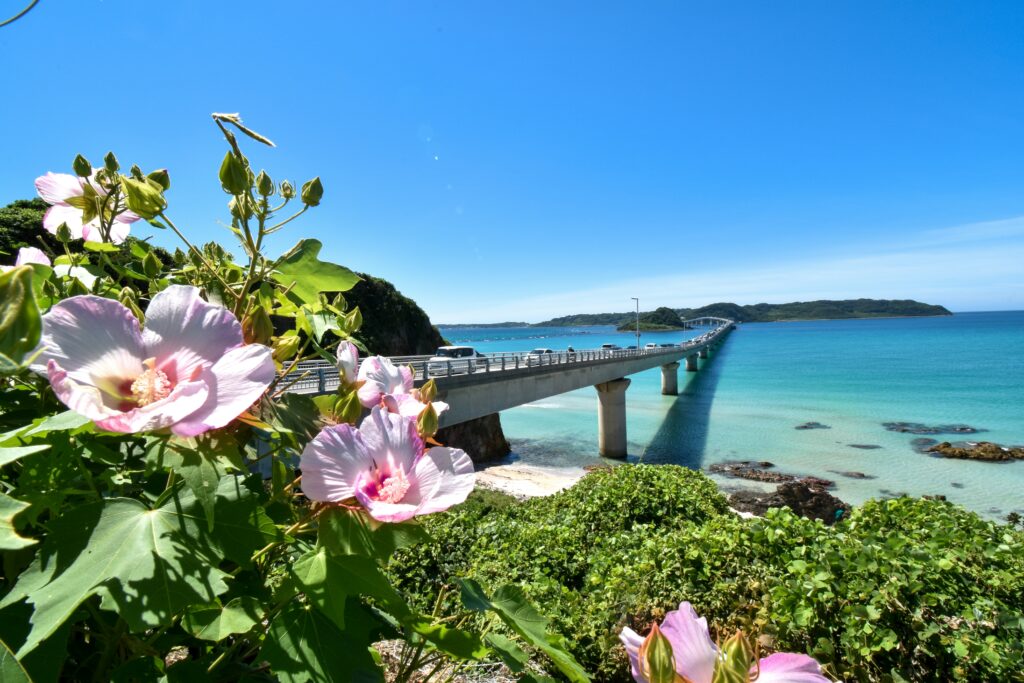
July marks the peak beach season in Japan. The weather is hot, and the ocean is warm, making it perfect for a day at the beach. Here are some of the best beach destinations to visit in July.
Kamakura
Yuigahama Beach: Close to Tokyo, Kamakura’s beaches, such as Yuigahama Beach, are popular for their relaxed vibe and scenic views. Yuigahama Beach is known for its sandy shores and gentle waves, making it a great spot for families and those looking to unwind by the sea. It’s also a great place to enjoy water sports such as paddleboarding and surfing.
- Official website: Kamakura Tourism
Okinawa
For a more tropical experience, the beaches of Okinawa offer crystal-clear waters and white sand. July is an ideal time to visit, as the weather is warm and the beach season is in full swing.
Naha
Naha, the capital city of Okinawa, has several beautiful beaches nearby. Naminoue Beach, located close to the city center, is a popular spot for both locals and tourists. It offers clear blue waters and is great for swimming and snorkeling.
- Official website: Naha Tourism
Nago
Nago, located in the northern part of Okinawa’s main island, is home to stunning beaches such as Busena Beach and Kise Beach. These beaches are perfect for sunbathing, swimming, and snorkeling, with pristine waters and beautiful coral reefs.
- Official website: Visit Okinawa
July in Japan: Rainy Day Activities

While July’s weather is generally sunny, there are still occasional rainy days. Here are plenty of indoor activities to enjoy during these times.
Museums and Galleries
Tokyo National Museum
Located in Ueno Park, this museum houses an extensive collection of Japanese art and antiquities. It is the oldest and largest museum in Japan, featuring exhibitions that span the country’s rich cultural history.
- Official website: Tokyo National Museum
Mori Art Museum
Situated in Roppongi Hills, the Mori Art Museum features contemporary art exhibitions and offers stunning views of Tokyo from its observation deck. The museum is known for its innovative and dynamic exhibits, showcasing both Japanese and international artists.
- Official website: Mori Art Museum
Aquariums
Osaka Aquarium Kaiyukan
One of the largest aquariums in the world, Kaiyukan is home to a diverse range of marine life, including a massive central tank with whale sharks. The aquarium’s exhibits recreate various habitats from the Pacific Rim, providing an immersive experience for visitors.
- Official website: Osaka Aquarium Kaiyukan
Sunshine Aquarium (Tokyo)
Located in Ikebukuro, this aquarium offers a unique rooftop setting and a variety of marine exhibits. The aquarium features an “oasis in the sky” theme, with beautiful displays of sea life set against the backdrop of the Tokyo skyline.
- Official website: Sunshine Aquarium
July in Japan: Staying Healthy
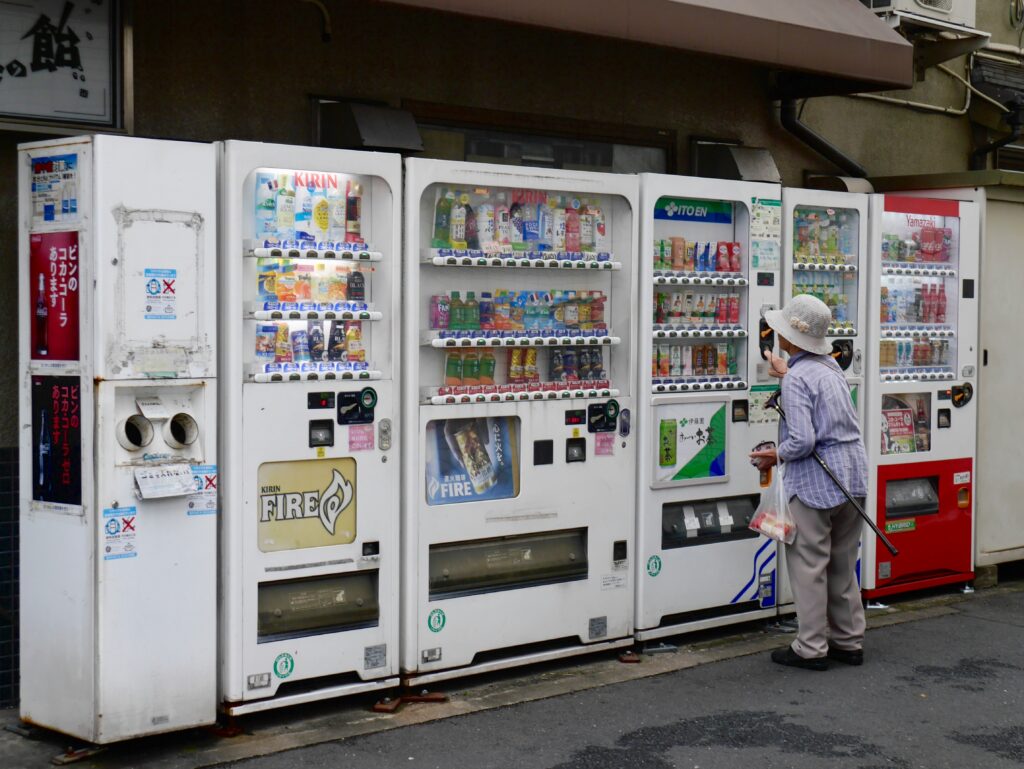
Travelling in Japan in July can be a wonderful experience, but the combination of warm temperatures and high humidity can present some health challenges. Here are some tips to ensure you stay healthy and comfortable during your trip.
Stay Hydrated
The combination of warm temperatures and high humidity can lead to dehydration. Here are some Japan-specific tips for staying hydrated:
- Carry a Water Bottle: Always have a reusable water bottle with you. Many public places, such as train stations and parks, have water fountains where you can refill your bottle.
- Vending Machines: Japan is famous for its ubiquitous vending machines, which are found on almost every street corner. These machines offer a wide variety of drinks, including water, sports drinks, and teas. During July, it’s important to stay hydrated, so take advantage of these convenient vending machines.
- Convenience Stores: Convenience stores like 7-Eleven, Lawson, and FamilyMart are also great places to grab a drink. They offer a variety of beverages, including cold drinks and electrolyte-replenishing options, which are perfect for staying hydrated in the humid weather.
- Seasonal Drinks: Try seasonal drinks like mugicha (barley tea), which is often enjoyed cold and is very refreshing during the hot summer months. This caffeine-free beverage is popular in Japan and is a great way to stay hydrated.
Mosquito Repellent
Mosquitoes can be more prevalent during the summer, especially in more rural or wooded areas. Here are some tips to avoid bites and potential discomfort:
- Pack Mosquito Repellent: Bring a good mosquito repellent with you. Products containing DEET or picaridin are effective. In Japan, you can also find local brands like Kincho, which offer various mosquito-repellent products, including sprays and wipes.
- Wear Appropriate Clothing: When hiking or spending time in nature, wear long sleeves and long pants to minimize exposed skin. Light-coloured clothing can also help, as mosquitoes are attracted to darker colours.
- Use Mosquito Coils: In rural areas or when sitting outside, use mosquito coils (katori senko), which are widely available in Japan. These coils release a mosquito-repellent smoke and are a common method for keeping mosquitoes at bay.
- Stay in Mosquito-Proof Accommodations: If you’re staying in rural areas, choose accommodations that offer mosquito nets or have screened windows. Many ryokans (traditional Japanese inns) and other lodgings in mosquito-prone areas will provide these.
Additional Health Tips
Protect Yourself from the Sun
- Use Sunscreen: The sun can be strong in July, so apply sunscreen regularly to protect your skin. Japanese pharmacies carry a variety of high-quality sunscreens, including brands like Biore and Shiseido.
- Wear a Hat and Sunglasses: A wide-brimmed hat and sunglasses can provide additional protection from the sun. Many Japanese stores offer stylish and functional options.
Avoid Heat Exhaustion
- Take Breaks: When exploring cities or hiking, take regular breaks in shaded or air-conditioned areas. Many attractions have rest areas where you can sit and cool down.
- Stay Cool: Carry a portable fan or cooling wipes. Japanese convenience stores sell small, battery-operated fans and refreshing body wipes that are perfect for cooling down on the go.
Eat Light and Nutritious Foods
- Seasonal Fruits and Vegetables: July is a great time to enjoy seasonal fruits and vegetables in Japan, such as watermelon, cucumbers, and leafy greens. These foods are not only nutritious but also help keep you hydrated.
- Cold Dishes: Try light, cold dishes like somen (thin wheat noodles served cold) and hiyayakko (chilled tofu topped with condiments). These refreshing meals are perfect for hot and humid days.
Making the Most of July in Japan
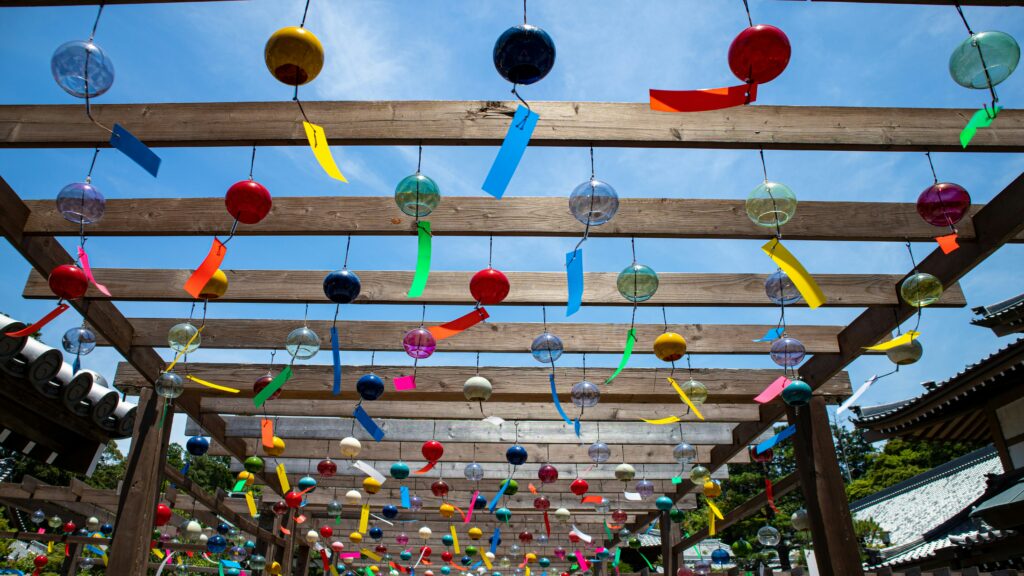
Travelling in Japan in July offers a unique and enriching experience, despite the heat and occasional rain. The lush greenery, vibrant festivals, and seasonal foods create a magical atmosphere. With the right preparation and a flexible itinerary, you can fully enjoy the beauty and culture of Japan during this special time of year.
Whether you’re exploring historic cities, hiking in the mountains, or savouring seasonal delicacies, July in Japan promises unforgettable memories. Embrace the sun, enjoy the festivities, and immerse yourself in the rich tapestry of experiences that only travelling in Japan in July can offer.



